Which Of These Animals Is The Largest Member Of The Dog Family?
35 species of wild dogs are currently recognized. They belong to the dog family, Canidae, which also includes all extinct domestic dog species. Members of the family unit Canidae are known every bit canids, and may also be referred to as 'canines'.
The world's wild dogs include animals known as wolves, foxes and jackals.
Well-known wild dog species include the gray wolf, coyote, crimson fox, Arctic play a trick on, kit fox, African wild dog and golden jackal.
The domestic dog is usually regarded as being a subspecies* of greyness wolf. (Some authorities regard the domestic canis familiaris as being a dissever species.)
* Subspecies are different 'types' of the same species. They are usually institute in different regions, and may have slight physical or behavioral differences. Different subspecies of the aforementioned species are able to breed and produce offspring.
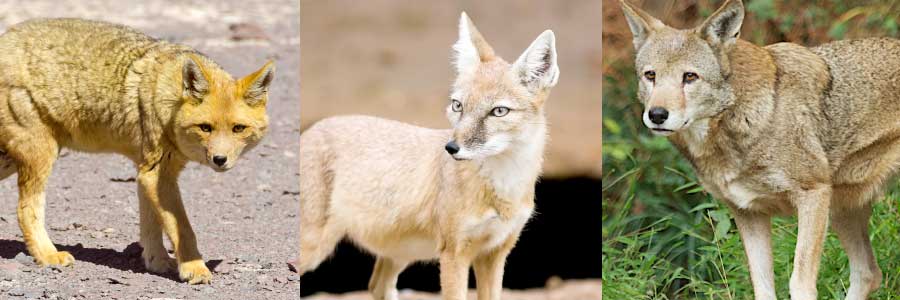
Canidae is one of several animal families that belong to the order Carnivora. Other families in this group include the true cat family (felidae), the carry family (Ursidae), and the seal families (Otariidae, Phocidae and Odobenidae). You can find out more about mammal classification on this page: Types of Mammals
Wild dogs are today constitute on all continents except Antarctica. (Although dogs are not native to Australia, the dingo was introduced to the continent around 3,500 years agone.)
Several wild dog species are endangered, ordinarily due to habitat loss or human incursion into their natural range.
For the list of dog species beneath we have used data from the Catalogue of Life, ITIS, and the IUCN. Conservation data was obtained from the IUCN Red Listing.
At the end of the list nosotros have also included notable dog subspecies (including the domestic dog), and species (such every bit the dingo and red wolf) that are recognized past some, but not all, regime.
You tin can click on the names of any of the types of wild dog listed below; you'll be taken to the relevant information further down the page.
Alternatively, keep scrolling to browse all the unlike types of wild domestic dog!
The number of living domestic dog species is liable to change in the future. This is considering enquiry into domestic dog classification is ongoing. Animals that today are regarded as beingness subspecies may in the future be regarded as being split species (and vice versa).
Wild Dog Species List: Alphabetize
Wild dogs list with pictures and information on all dog species.
- African Gold Wolf (Canis anthus / Canis lupaster)
- African Wild Canis familiaris (African Hunting Domestic dog / African Painted Dog) (Lycaon pictus)
- Arctic Play tricks (Vulpes lagopus)
- Bat-Eared Fox (Otocyon megalotis)
- Bengal Fox (Vulpes bengalensis)
- Black-Backed Jackal (Canis mesomelas)
- Blanford's Fox (Vulpes cana)
- Bush Dog (Speothos venaticus)
- Cape Fox (Vulpes chama)
- Corsac Fox (Vulpes corsac)
- Coyote (Canis latrans)
- Crab-Eating Fox (Cerdocyon thous)
- Culpeo (Lycalopex culpaeus)
- Darwin'south Fox (Lycalopex fulvipes)
- Dhole (Cuon alpinus / Canis alpinus)
- Ethiopian Wolf (Canis simensis)
- Fennec Fox (Vulpes zerda)
- Gold Jackal (Canis aureus)
- Gray Pull a fast one on (Urocyon cinereoargenteus)
- Grey Wolf (Canis lupus)
- Hoary Fob (Lycalopex vetulus)
- Island Fox (Urocyon littoralis)
- Kit Play tricks (Vulpes macrotis)
- Maned Wolf (Chrysocyon brachyurus)
- Pale Play tricks (Vulpes pallida)
- Pampas Fox (Lycalopex gymnocercus)
- Raccoon Dog (Nyctereutes procyonoides)
- Red Fox (Vulpes vulpes)
- Rüppell's Fox (Vulpes rueppelli)
- Sechuran Fox (Lycalopex sechurae)
- Short-Eared Domestic dog (Atelocynus microtis)
- Side-Striped Jackal (Canis adustus)
- Southward American Grayness Fox (Lycalopex griseus)
- Swift Fox (Vulpes velox)
- Tibetan Sand Fox (Vulpes ferrilata)
Other Canids
- Cozumel Play tricks (Undescribed Species, perchance extinct)
- Dingo (Canis lupus dingo)
- Domestic Dog (Canis lupus familiaris)
- Red Wolf (Canis rufus)
Decision & Further Reading
Alphabetical Wild Dogs Species List With Pictures
African Golden Wolf
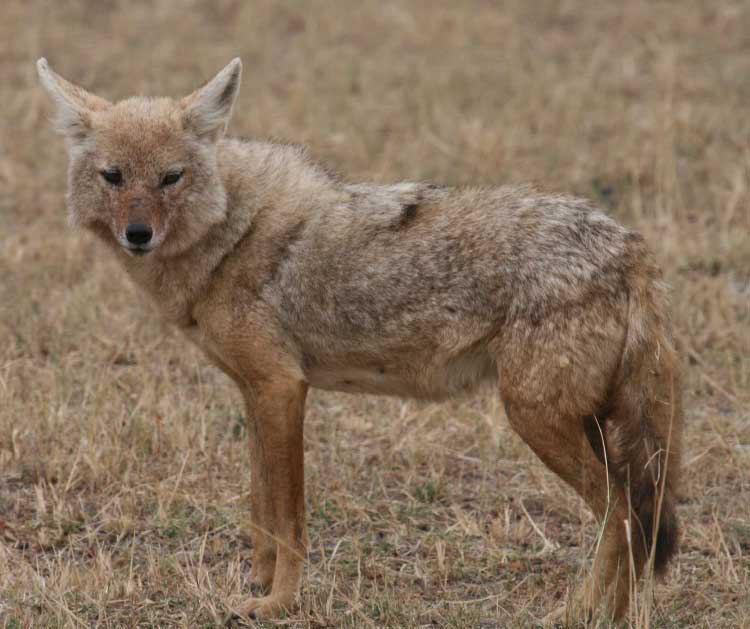
- Scientific name: Canis anthus / Canis Lupaster
- Where constitute: Africa
- Conservation status: To the lowest degree Business
The African golden wolf is plant in n and northeast Africa. Countries in which the species is present include Egypt, People's democratic republic of algeria and Ethiopia.
A relatively small dog species, the African golden wolf weighs between vii and 15 kg (fifteen and 33 lb), and stands around 40cm / 16 in. tall; that's around one-half the weight and 2 thirds of the meridian of a typical labrador. Information technology is a desert specialist, able to live in areas with petty water.
The coat of the African gold wolf ranges in colour from silver-grayness to light sandy-chocolate-brown. The species was, until recently, thought to be the same species as the Golden Jackal. Scientists now believe that there are sufficient differences between each brute for them to be considered separate species.
Dorsum to alphabetize
African Wild Dog
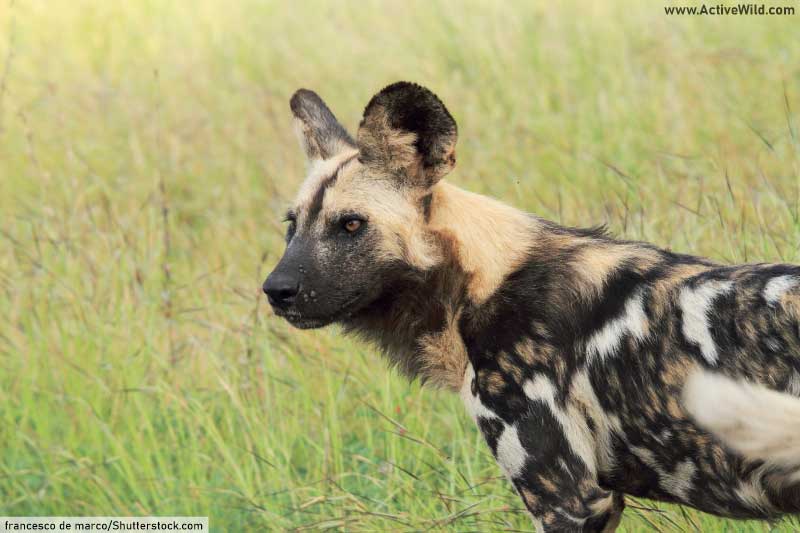
- Other name(s): African hunting dog, African painted domestic dog
- Scientific name: Lycaon pictus
- Where plant: Africa
- Conservation status: Endangered
This distinctively-colored wild domestic dog lives in scattered colonies throughout much of Africa. The species lives in groups which usually consist of an blastoff male and female and the pair's offspring. The pack hunts using teamwork, pursuing its prey–unremarkably a medium-sized antelope–until it tires.
The African wild dog is easily identified due to its patterned coat, which gives the species its alternative proper noun of African Painted Dog.
It is a relatively large species, weighing upwardly to 30 kg (66 lb) and with a shoulder height of 75 cm (30 in).
The African wild dog is listed every bit Endangered on the IUCN Carmine List (source). It is estimated that fewer than 1,500 adult individuals remain in the wild. The species' population is fragmented over a wide area.
- You can read more about African wild dogs on this page: African Wild Dog facts.
- Find out about endangered animals hither: Endangered Animals Facts.
Back to index
Arctic Fox
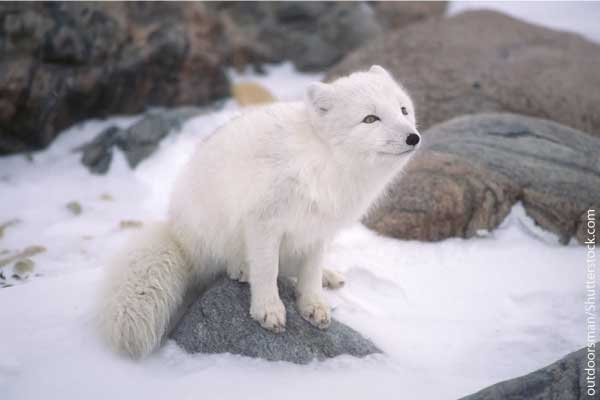
- Scientific name: Vulpes lagopus
- Where found: Arctic regions of North America, Europe and Asia
- Conservation status: To the lowest degree Business
The Arctic fox belongs to the genus Vulpes–a grouping whose members are known as 'truthful foxes'.
This small canid is a survival specialist, having a number of adaptations for life in the cold northern parts of the world. Its thick, insulating coat changes color with the seasons, existence white in the winter and brown during the summer months. It is the only member of the dog family with furry foot pads.
An adult male Chill fox is around xxx cm (11.8 in) tall at the shoulder, and weighs upward to 9.4 kg (20.7 lb); around half the size of a typical labrador.
- You tin observe out more than about the Chill play a joke on hither: Arctic Fox Facts.
Back to index
Bat-Eared Play tricks
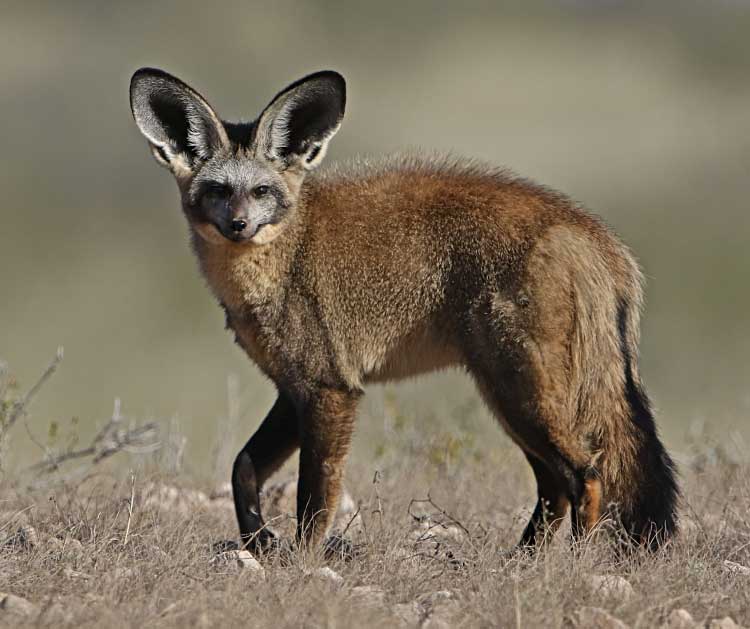
- Other name(s): Delalande's fob, long-eared fob
- Scientific proper noun: Otocyon megalotis
- Where found: Africa
- Conservation condition: To the lowest degree Concern
Named later on its distinctive ears, the bat-eared flim-flam is an African canid typically establish in dry grassland habitats. The species uses its large ears to locate termites, which make upwards equally much as 80% of its diet. Small teeth and jaws that can open and close up to 5 times per second are adaptations for the species' insectivorous (insect-eating) lifestyle.
In that location are two, geographically separate, bat-eared play a trick on populations; one in Southern Africa, the other in eastern Africa.
Dorsum to index
Bengal Fox
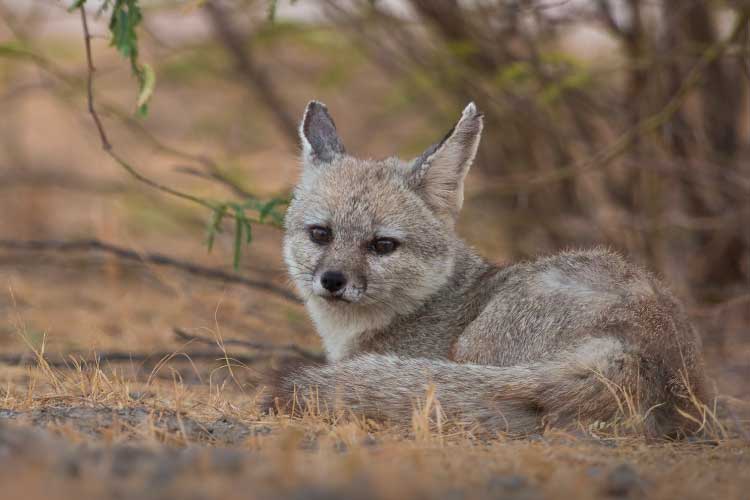
- Other name(s): Indian pull a fast one on
- Scientific name: Vulpes bengalensis
- Where plant: Asia (Indian Subcontinent)
- Conservation status: Least Concern
The Bengal Fox is a small wild dog found only on the Indian subcontinent. Information technology has a pale coat and the typical bushy tail of true foxes of genus Vulpes. Its tail is at to the lowest degree one-half the length of its combined caput and body length, and has a distinctive blackness tip. The species weighs between two.3 and 4.i kg (5 and ix pounds).
This Asian wild dog unremarkably inhabits dry grasslands, and avoids dense forests and desert regions. A social animal, the Bengal fox lives in large underground dens.
Although its population is declining due to habitat loss, the Bengal Play a trick on is rated Least Concern by the IUCN.
Dorsum to index
Blackness-Backed Jackal
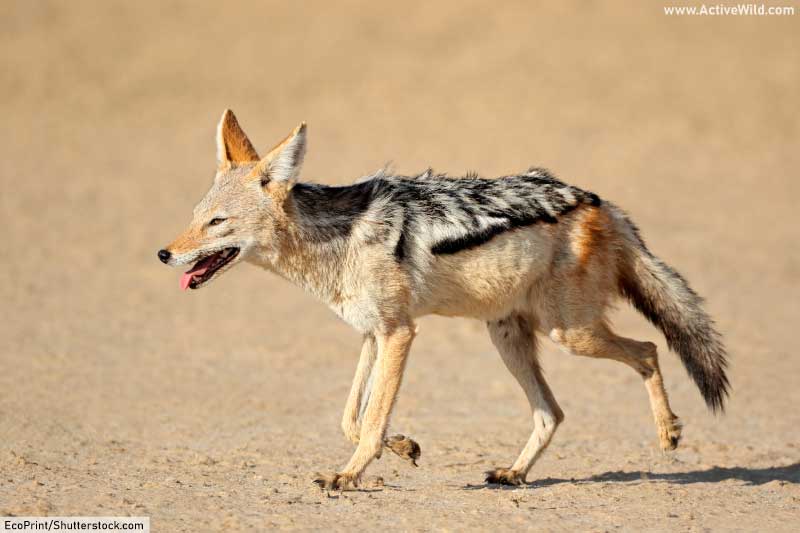
- Scientific proper noun: Canis mesomelas
- Where constitute: Africa
- Conservation condition: To the lowest degree Concern
The black-backed jackal is 1 of the oldest species of genus Canis, having appeared 2 to three million years ago. The species gets its name from the thick black fur on its back. Its sides and undersides are a paler, sandy-orange colour. Information technology has long ears and a pointed snout.
The black-backed jackal lives in a variety of habitats, but is most unremarkably found in areas with sparse vegetation, including savannas and deserts. Like the bat-eared fox, it is found in two, dissever regions of Africa. 1 subspecies is found in southern Africa, the other in eastern Africa.
- You can find out more almost the black-backed jackal on this page: Black-Backed Jackal Facts
Back to index
Blanford'southward Fox
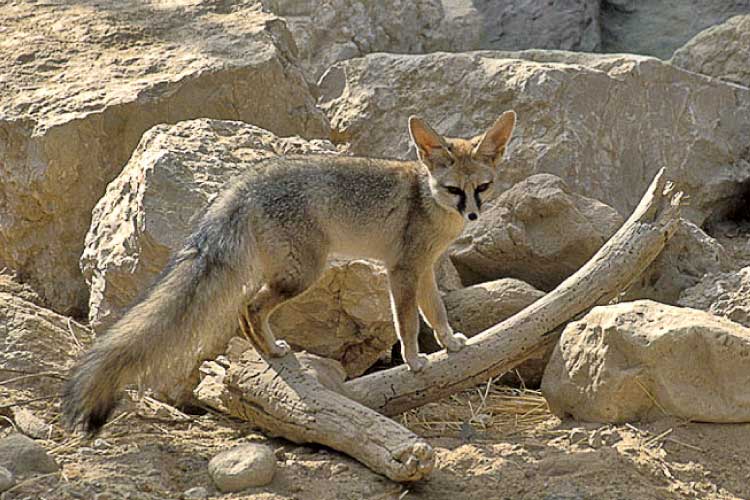
- Other proper noun(s): Afghan fox, regal play a joke on
- Scientific name: Vulpes cana
- Where institute: Middle East, Asia
- Conservation status: Least Business organization
Blanford's fox is a wild dog species found in desert and mountainous regions of the Middle East and Central Asia. It is named later on William Thomas Blanford, an English naturalist known for his study of Indian animals.
This small play a joke on weighs between 0.9 and i.5 kg (2 and 3.3 lb). An excellent climber, the species uses its long, bushy tail for balance. Its large ears assist information technology to stay cool in the desert heat. The species can exist recognized by two distinctive dark stripes on its confront.
Back to index
Bush Dog
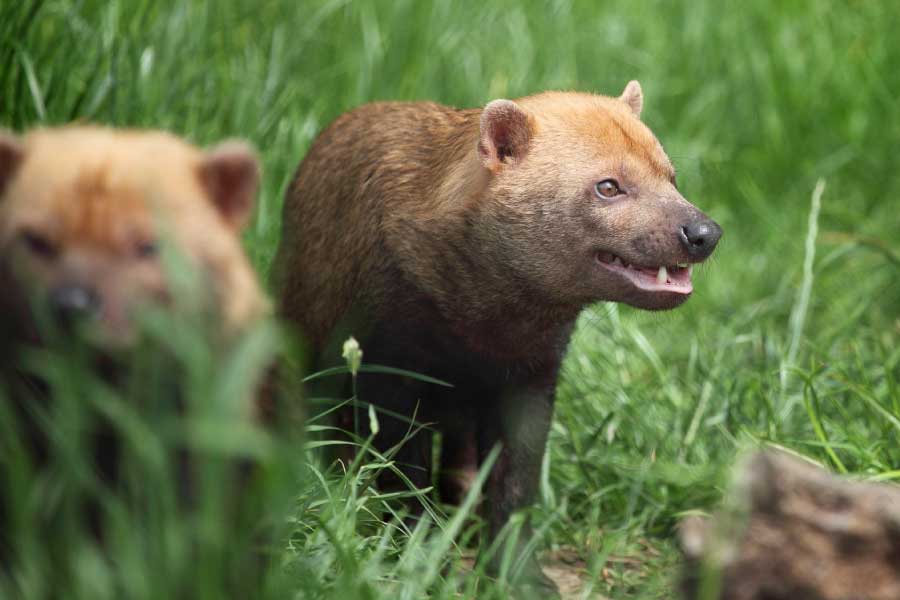
- Scientific proper name: Speothos venaticus
- Where establish: S America
- Conservation condition: Most Threatened
The bush dog is a rare South American Canid. It commonly lives well-nigh h2o in rainforests and savannas, and has partially-webbed toes for swimming. The species has a long, squat body with short legs and a curt tail, giving information technology a badger-similar appearance.
Due to habitat loss, population fragmentation and lack of prey species, the bush dog has the conservation status of 'Near Threatened'.
Back to alphabetize
Cape Play tricks
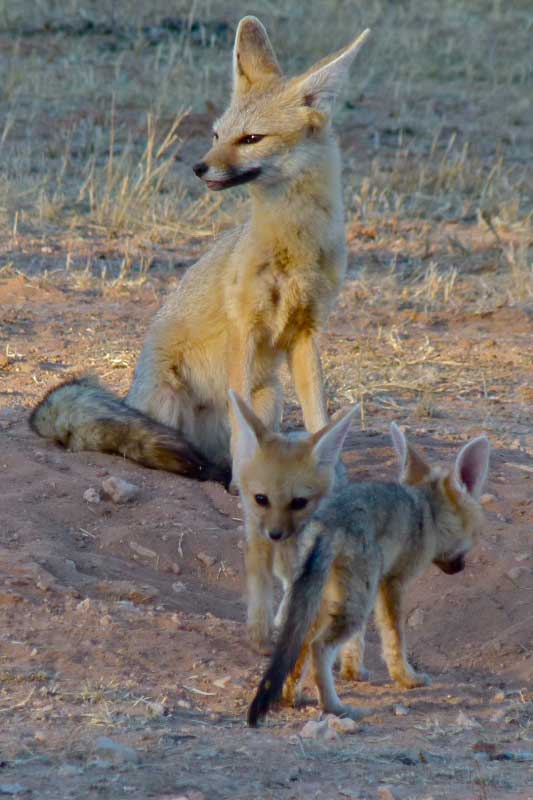
- Other name(s): asse, cama pull a fast one on, argent-backed fox
- Scientific proper noun: Vulpes chama
- Where constitute: Southern Africa
- Conservation status: Least Business organization
The Cape fox is the simply species of genus Vulpes found in Africa. (Animals of genus Vulpes are known every bit 'truthful' foxes.)
This modest African canid has a gray-brown coat, pale yellow undersides and a long, bushy, blackness-tipped tail. Information technology weighs between 3.6 and 5 kg (8 and 11 lb) and stands upwards to 33 cm (13 in) at the shoulder.
The Cape fox lives in grasslands and semi-desert scrub. Information technology is found in Angola, Botswana, Namibia and South Africa. It is common throughout its range and rated Least Concern by the IUCN.
Back to index
Corsac Fox
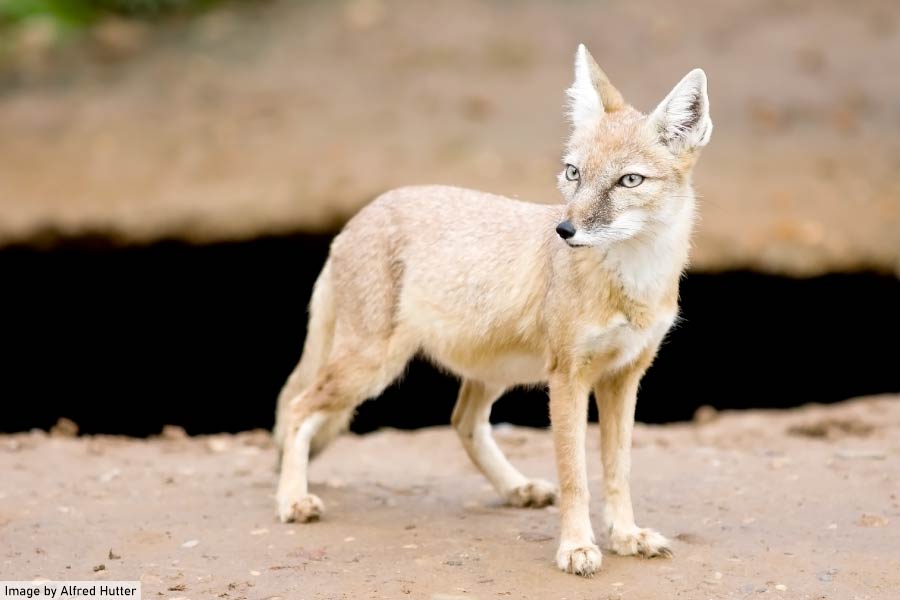
- Other proper noun(due south): corsac, steppe trick
- Scientific name: Vulpes corsac
- Where institute: Fundamental Asia
- Conservation status: Least Concern
The corsac fob lives in the steppes (treeless grasslands) of Central Asia, and is also known every bit the steppe fox. It is a mid-sized fox, weighing between 1.half-dozen and 3.ii kg (3.v and seven.1 lb). The species' long fur thickens and becomes paler during the winter.
Despite beingness heavily hunted for its fur, the corsac fox remains widespread and common throughout its range.
Back to index
Coyote

- Other name(s): Prairie Wolf
- Scientific name: Canis latrans
- Where constitute: Due north America
- Conservation status: To the lowest degree Concern
The coyote is a mutual canid species institute throughout North and Central America. This adaptable member of the dog family is able to live in a wide range of habitats, from prairies to forests. Unlike its close relative the grey wolf, it will also live well-nigh to human being settlements. Occasionally a coyote and wolf will mate, creating hybrids known as 'coywolves'.
- You lot can find out more about the coyote on this page: Coyote Facts
Back to index
Crab-Eating Fox
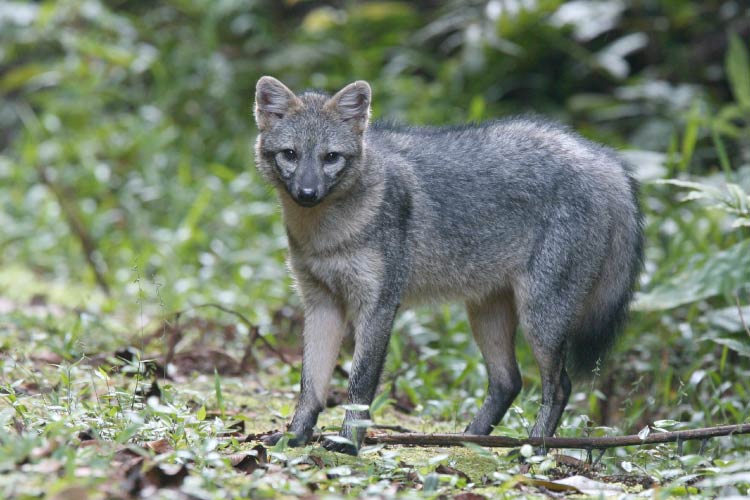
- Other name(due south): forest fox, forest fox, bushdog, maikong
- Scientific name: Cerdocyon thous
- Where found: South America
- Conservation status: Least Concern
The crab-eating fox is a relatively common South American canid. It is found in a diverseness of habitats, including marshland, savanna and forests. The species has curt, dark grey fur and relatively brusque legs. It raises its tail when excited. Weighing betwixt 4.5 and 7.7 kg (10 and 17 lb), the crab-eating fox is significantly smaller than a medium-sized domestic dog.
This South American wild dog spends the mean solar day in an secret den, emerging at dusk to hunt. Individuals living by floodplains are known to search for crabs in the mud; a habit after which the species is named. The crab-eating fox volition also eat a wide variety of other animals, every bit well equally plant material.
The species is known to accept been kept as a pet past indigenous people.
Back to index
Culpeo
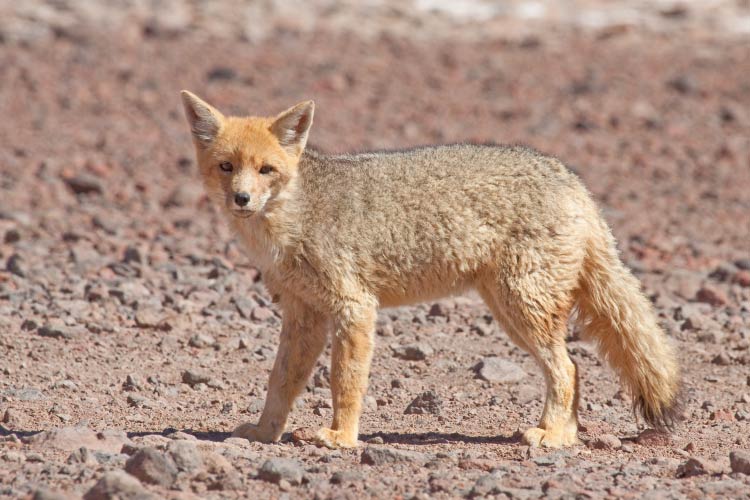
- Other name(southward): zorro culpeo, Andean zorro, Andean fox
- Scientific name: Lycalopex culpaeus
- Where found: South America
- Conservation condition: To the lowest degree Business
The culpeo is the second-largest member of the canis familiaris family found in South America (later on the maned wolf). The species belongs to the genus Lycalopex, a group of animals known as the 'South American foxes', or 'zorros' in Spanish.
Slightly smaller than a coyote, the Culpeo has grey-ruby or yellowish fur and a bushy tail. It inhabits a variety of habitats, and is present from southern Columbia to southern Chile. The species is almost mutual on the western slopes of the Andes.
Dorsum to index
Darwin's Pull a fast one on

- Other name(s): Darwin's zorro
- Scientific proper name: Lycalopex fulvipes
- Where institute: S America (Republic of chile)
- Conservation condition: Endangered
Darwin's Pull a fast one on was discovered by English naturalist Charles Darwin. This rare canid is found in simply iii places in Chile: Nahuelbuta National Park, the Valdivian Coastal Range, and on the Island of Chiloé. It lives in forests, and is rarely seen.
With a maximum weight of just under 4 kg (viii.8 lb)–one tenth of the weight of a big German shepherd–Darwin'south Flim-flam is one of the smallest members of the domestic dog family.
The main threat to the endangered Darwin'southward Flim-flam comes from domestic dogs, which assault the wild species and too spread disease.
Back to index
Dhole
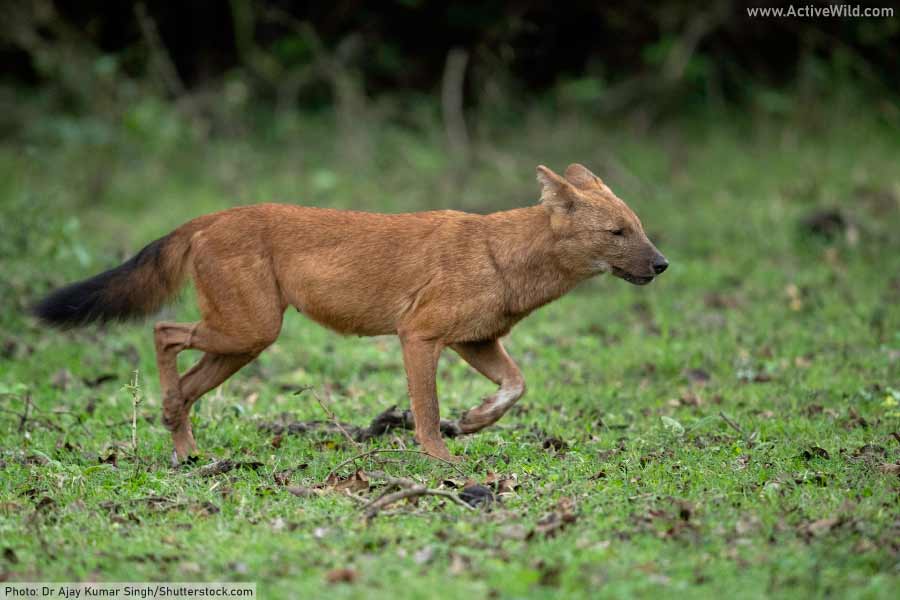
- Other names: Asian wild dog
- Scientific name: Cuon alpinus
- Where found: Asia
- Conservation status: Endangered
The Dhole is found in Primal, South and Southeast Asia. It lives in a variety of habitats, including rainforests and grasslands.
This large member of the dog family tin can weigh upwards to xl kg (88 lb); around twice the weight of a Coyote. Dholes resemble members of the genus Canis (Domestic Dogs, Grey Wolves), but have fox-like red fur and bushy tails.
The Dhole is a social creature, living in packs of around twelve, only sometimes forming larger groups of 30 to forty animals.
The Dhole shares parts of its range with large felids such every bit tigers and leopards. Either of these big cats will always win a one-on-1 run into. Yet, the dhole'south strength is teamwork and a pack of dholes may encounter off and fifty-fifty kill an individual tiger or leopard!
Dholes are Endangered, mainly to habitat loss.
- You can find out more most this wild dog species on this page: Dhole Facts
Back to alphabetize
Ethiopian Wolf
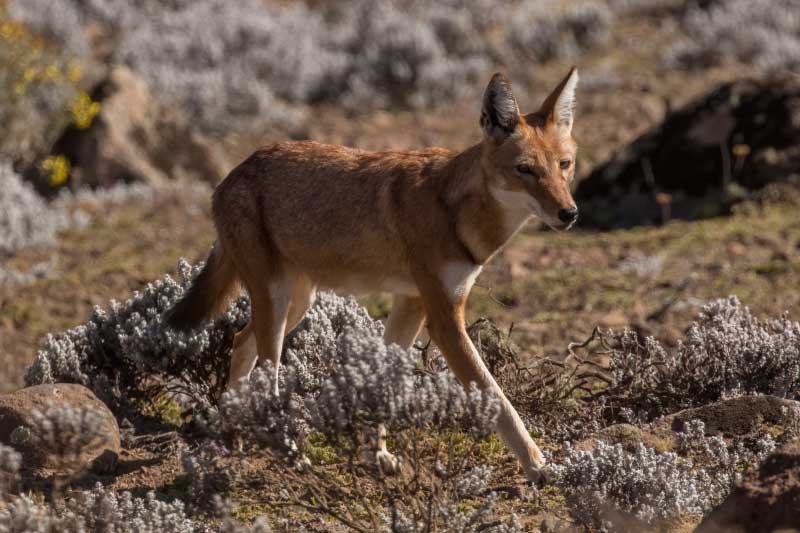
- Other names: Abyssinian Wolf, Simien Trick, Simien Jackal
- Scientific name: Canis simensis
- Where found: Africa
- Conservation status: Endangered
The Ethiopian Wolf is endemic to Ethiopia, where it lives in the mountainous Ethiopian Highland region. Its nutrition consists mainly of rodents, which it hunts during the twenty-four hours.
The Ethiopian Wolf is a medium-sized Canid, with an average weight of 16 kg (35 lb). It has a cherry-red-brown coat and white chest.
With fewer than 200 mature individuals left in the wild, the Ethiopian Wolf is the world'southward most threatened Canid, and Africa's most endangered carnivore. The species' main threat is habitat loss caused by the region's expanding human population.
Back to index
Fennec Fox
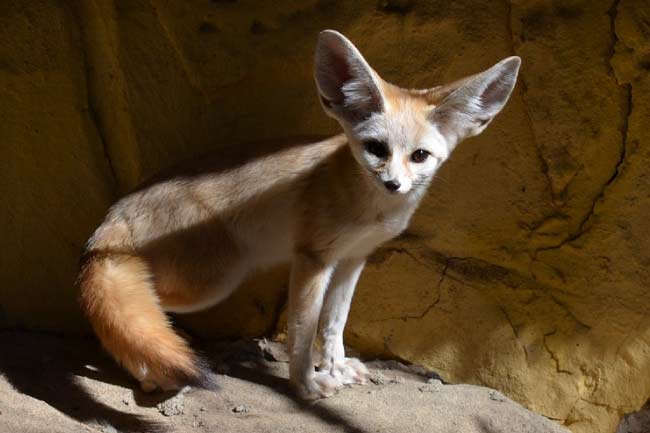
- Scientific name: Vulpes zerda
- Where establish: Africa
- Conservation status: Least Concern
Weighing between 1 and 1.9 kg (2.2 and 4.two lb), the fennec fob is the smallest fellow member of the dog family unit.
This African wild canis familiaris is found in hot, arid parts of Due north Africa, including the Sahara Desert. It has a number of adaptations for life in this inhospitable habitat, including a pale, orange-white glaze that reflects heat, and thick fur on the lesser of its paws that allows information technology to walk over hot sand.
The fennec trick's distinctively big ears serve a dual purpose: they help continue the fox cool by dissipating heat and too let the play tricks to hear casualty animals moving effectually surreptitious.
- You tin can notice out more than virtually the fennec fox here: Fennec Fox Facts
Back to alphabetize
Golden Jackal
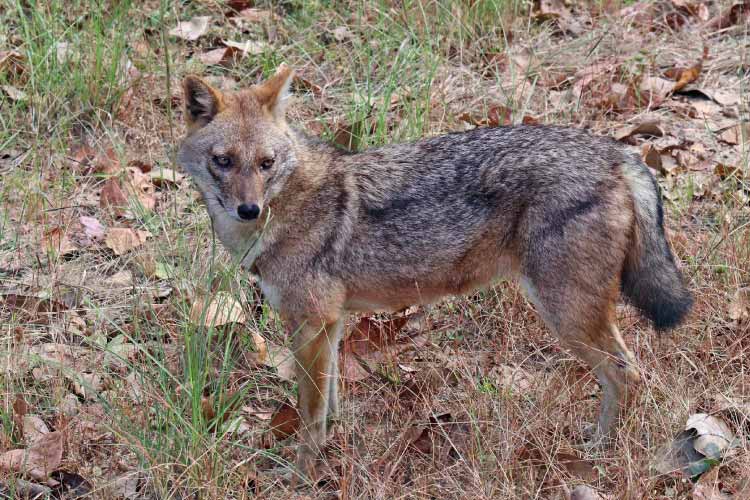
- Scientific proper noun: Canis aureus
- Where institute: Europe, Asia
- Conservation status: Least Concern
The Golden Jackal looks like a minor wolf, and is more closely related to the gray wolf than it is to the 2 African jackal species (the blackness-backed jackal and the side-striped jackal).
The Gilt Jackal'due south range stretches from Eastern Europe, across the Eye Eastward and Asia to Vietnam. The species was once thought to inhabit Africa, but those animals are now considered to be a separate species: the African gilded wolf.
The adaptable Golden Jackal tin can live in a wide range of habitats, including forests and grasslands. It will either hunt or scavenge for food. Its population is increasing and its conservation status is currently To the lowest degree Concern.
Dorsum to index
Gray Flim-flam
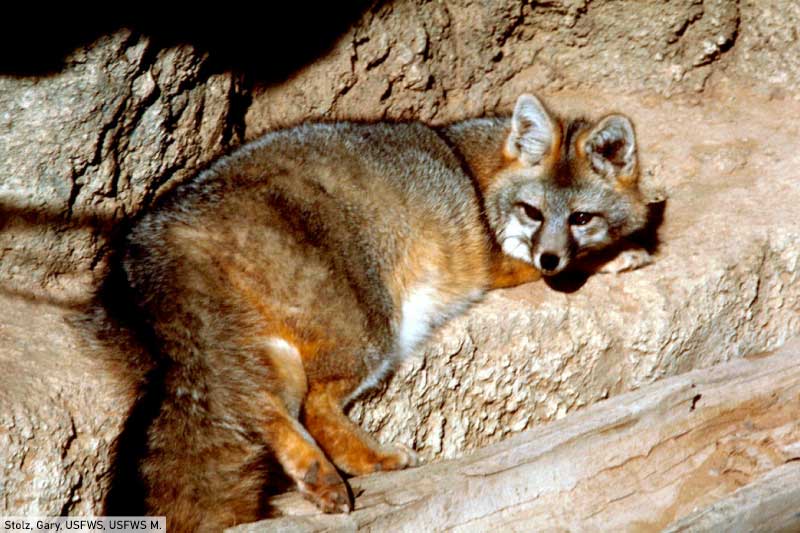
- Scientific name: Urocyon cinereoargenteus
- Where found: N America, (northern) South America
- Conservation status: To the lowest degree Business organisation
The Gray Fox is an American canid whose range covers southern Canada to northern South America. It is found throughout the U.s., where it is the most common play tricks species in the Pacific states. Its coat is a mixture of greys, blackness and stake oranges, and the species can exist identified by the grey/silver fur on its back. A dark line runs down the center of the back of its tail.
This widespread dog species is establish in a broad variety of habitats, including forests, scrubland and rocky environments.
The Gray Fox is ane of the few canids able to climb trees, and is the simply American canid able to practise and so.
- You lot tin can find out more about the gray fox on this folio: Grey Fox Facts
Back to alphabetize
Greyness Wolf
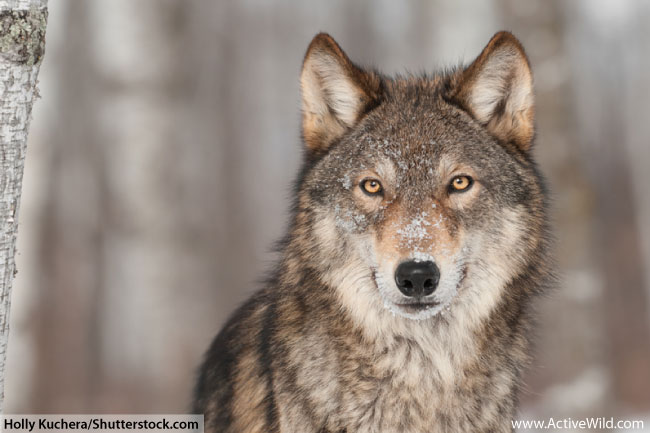
- Scientific proper name: Canis lupus
- Where found: N America, Europe, Asia
- Conservation status: Least Concern
The grey wolf is the largest wild domestic dog species, and perhaps the best-known. Once the near widely-distributed of all land mammals (that title at present belongs to the scarlet fox), the greyness wolf is constitute across much of North America, Europe, and Asia. Information technology typically inhabits wilderness areas well away from man settlements. The wolf's range has decreased due to the spread of humans.
The gray wolf's size and advent varies throughout its range. A large wolf can weigh up to 54 kg (120 lbs), and stand up to 85 cm / 33.5 in. at the shoulders; individuals far larger than this accept been known. European wolves tend to exist larger than those found in Due north America.
Wolves are territorial and usually live in family groups known as packs. They hunt either singly, in pairs, or in a pack. Fifty-fifty lonely wolves are able to capture large prey. Wolves have a varied diet, which includes large animals such every bit moose and muskoxen, and smaller mammals and birds.
Much myth and legend surrounds the gray wolf. Its howl is one of nature's most evocative sounds.
Upwardly to 38 subspecies of wolf have been identified. These include the Eurasian wolf, eastern wolf and Arctic wolf. The cherry wolf, dingo and domestic dog are usually considered to exist subspecies of gray wolf, but are regarded by some authorities as existence separate species.
- You lot can find out more near (Eurasian) wolves on this page: Eurasian Wolf Facts
Back to index
Hoary Fox
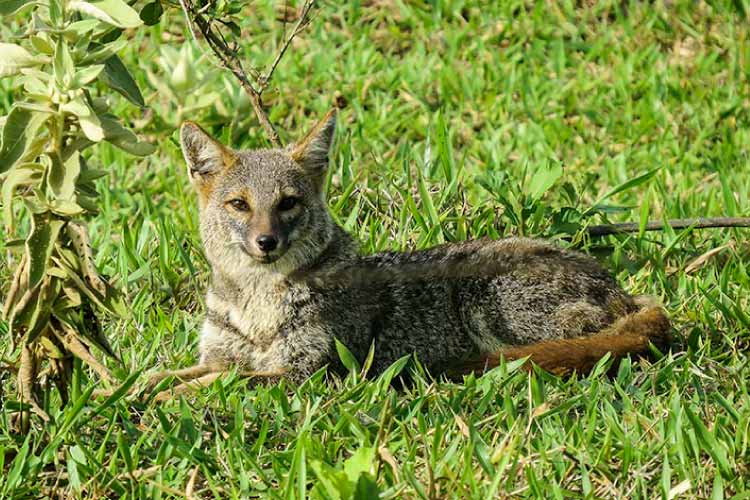
- Other name(s): Hoary zorro
- Scientific name: Lycalopex vetulus
- Where found: Brazil
- Conservation condition: Most Threatened
The Hoary Fox is a modest fox owned to (only constitute in) Brazil. The species mainly inhabits the savannas of the Cerrado, a large ecoregion in fundamental Brazil.
The nutrition of this nocturnal South American canid consists mainly of insects. It will likewise prey on minor vertebrates such as rodents and birds.
Back to index
Island Fox
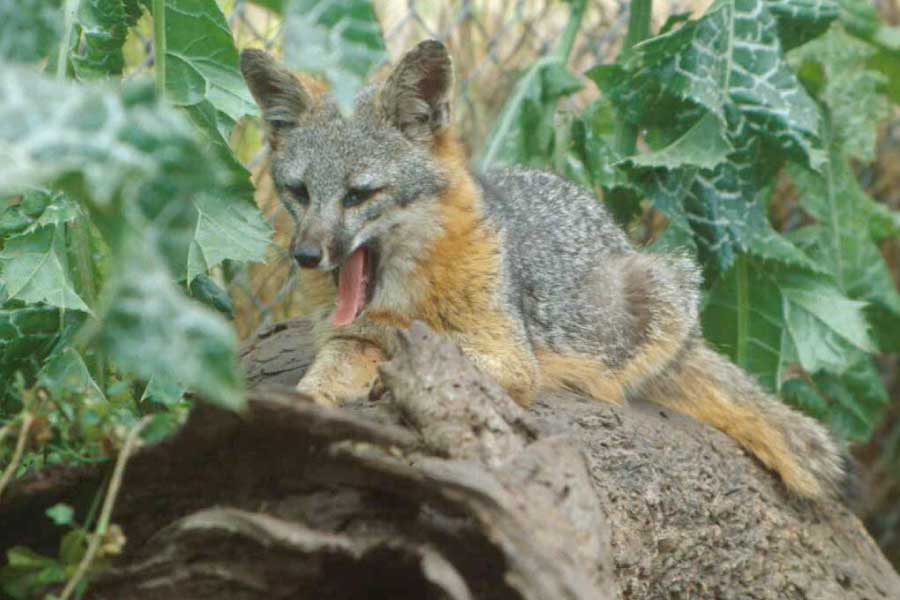
- Scientific name: Urocyon littoralis
- Where constitute: California Channel Islands, Usa
- Conservation status: Near Threatened
The island flim-flam is a small play a joke on establish on six of the viii Aqueduct Islands located off the coast of California. It is descended from the gray play tricks, which inhabits the mainland.
The isle fox's modest size is an example of insular dwarfism. This is the biological phenomenon in which species confined to a small area (such as an island) adapt to their surroundings by condign significantly smaller than their mainland ancestors.
Following severe population declines in the 1990'south, the Island Fox became Critically Endangered. Several conservation programmes were put into place, and the species' population is now increasing.
Back to index
Kit Fox
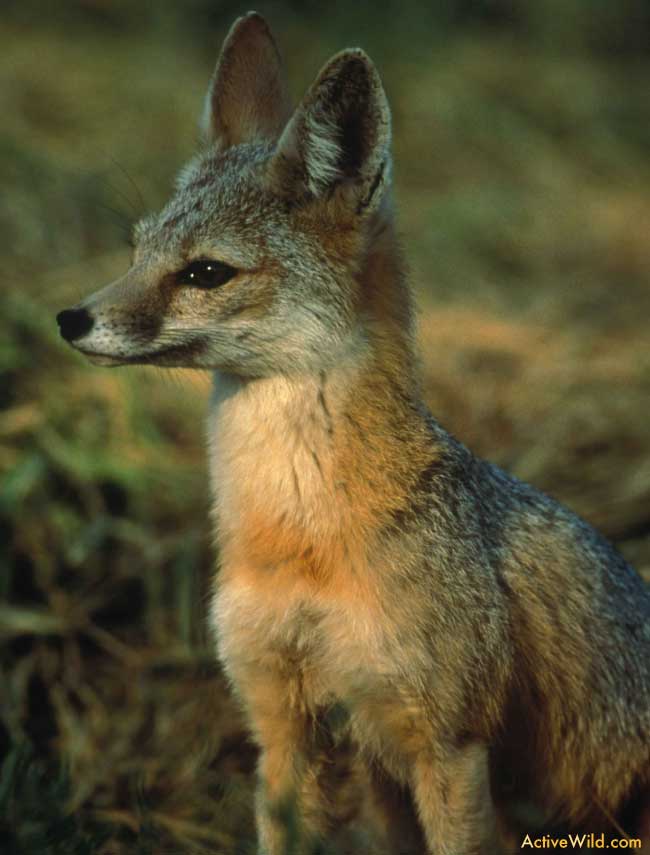
- Scientific proper noun: Vulpes macrotis
- Where found: North America
- Conservation status: Least Business
The kit flim-flam is a minor canid found in arid and desert habitats in the USA and Mexico. Similar the fennec fox, the kit pull a fast one on has large ears; an adaptation for living in that desert that provides both a means of reducing the animal'due south body rut, and astute hearing.
- You tin can find out more than about the kit pull a fast one on on this page: Kit Fox Facts
Back to alphabetize
Maned Wolf
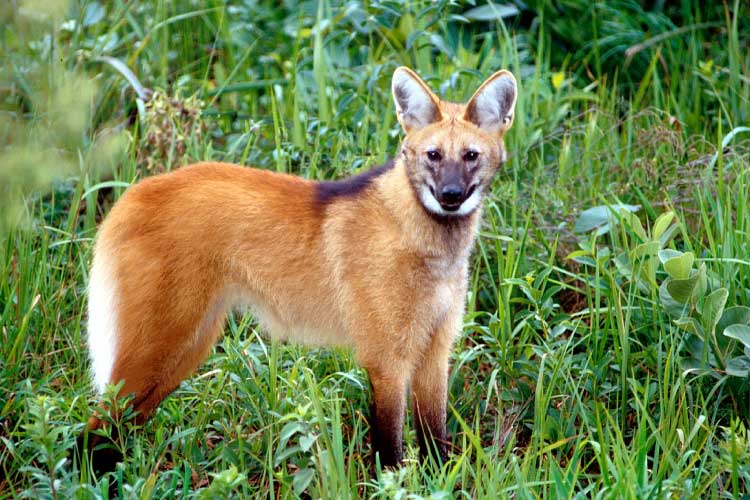
- Scientific name: Chrysocyon brachyurus
- Where found: South America
- Conservation status: Nigh Threatened
The maned wolf is the largest fellow member of the dog family constitute in Due south America, and the tallest of all canids. It is found in grasslands and open woodlands in Argentina, Bolivia, Brazil, Paraguay and Peru.
The species is distinctive, having long legs, a shaggy mane and a red-brown glaze. With an average weight of 23 kg (51 lb), and shoulder superlative of 90 cm (35 in), the maned wolf is taller, but significantly lighter, than the grey wolf.
Dorsum to index
Pale Fox
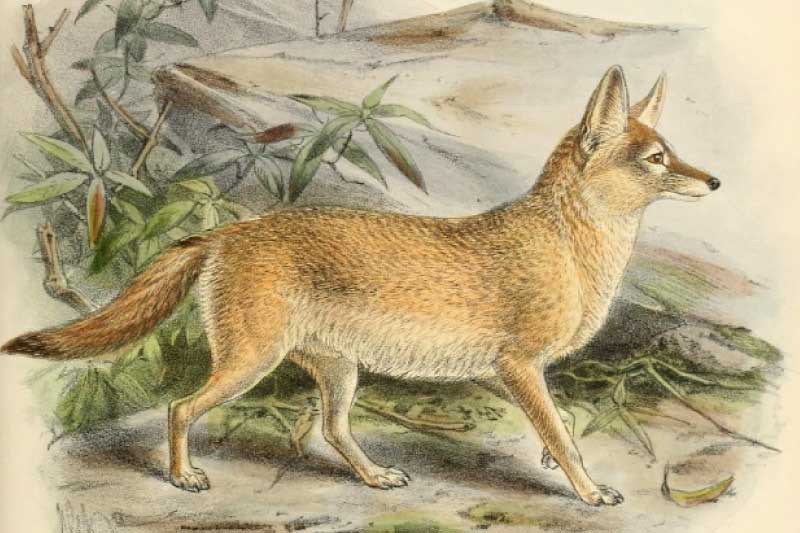
- Scientific name: Vulpes pallida
- Where constitute: Africa
- Conservation status: To the lowest degree Business organisation
The stake fob inhabits dry out sandy and rocky areas south of Africa'southward Sahara Desert. This small wild dog has a pale, sandy glaze. Like other desert-living canids, it has large ears.
The species leads a nocturnal lifestyle. Information technology digs burrows in which it rests during the mean solar day. It hunts at nighttime, preying on a multifariousness of small vertebrates and insects.
Dorsum to index
Pampas Fox
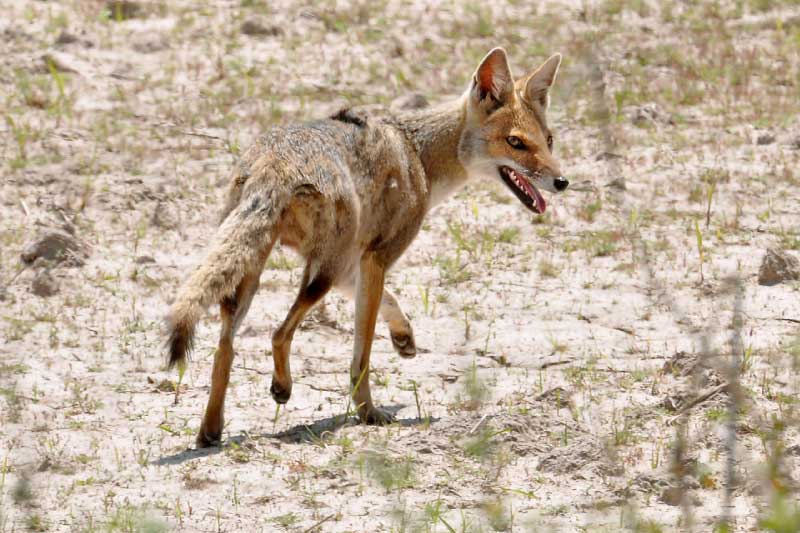
- Scientific proper noun: Lycalopex gymnocercus
- Where found: South America
- Conservation status: To the lowest degree Concern
As its name suggests, the Pampas fox is constitute in the S American Pampas. These vast lowland grasslands are located in Argentina, Brazil and Uruguay.
The Pampas fox, being a fellow member of the Due south American genus Lycalopex, is a 'zorro', or 'imitation fox', rather than a 'truthful fox' of genus Vulpes. However (like all zorros) information technology is typically fox-like in appearance, having a pointed snout, erect ears and a bushy tail. Its pale, sandy-colored glaze reflects the dry grasslands and sandy terrain in which information technology is commonly found.
Today, some authorities consider the Pampas fox and the Due south American gray fox to be the same species.
Back to alphabetize
Raccoon Canis familiaris
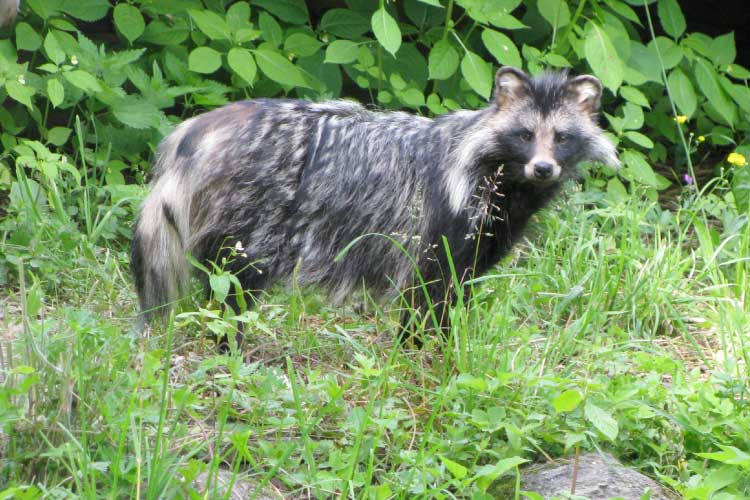
- Scientific name: Nyctereutes procyonoides
- Where found: Europe, Asia
- Conservation status: Least Concern
The raccoon dog, as its proper name suggests, resembles a raccoon, with its wide furry face and short, squat body. It is a relatively undeveloped fellow member of the dog family unit. Like the grey fob, it is one of the few canids that climbs trees.
Originally found in East Asia, the raccoon dog was introduced to western Russian federation in the early 20th century in order that its fur may exist harvested. The species has now spread into much of Eastern Europe, and is now present equally far west every bit Espana. In some areas information technology is considered an invasive species.
Back to index
Red Fox
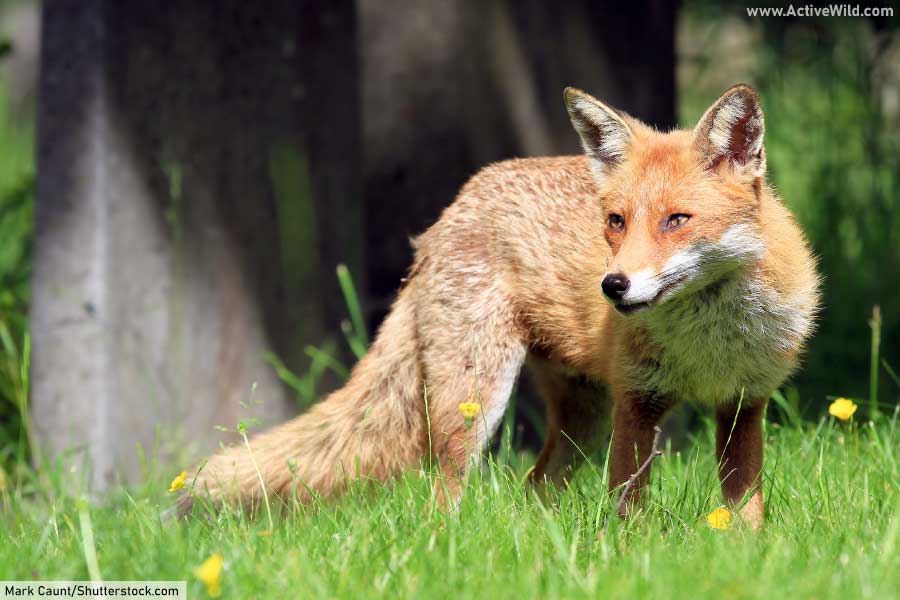
- Scientific name: Vulpes vulpes
- Where found: N America, Europe, Asia, (North) Africa, Australia, New Zealand
- Conservation status: Least Business concern
The red fox is the world'due south virtually widely-distributed land mammal. It is found beyond a wider area than even the brown rat or the house mouse. Its range covers North America, Europe, much of Asia and Due north Africa. The species was also introduced in Australia, where information technology is now considered an invasive species.
The blood-red play a trick on is recognisable past its cherry-red glaze, white chest and underparts, and bushy tail. Information technology is the largest member of the 'true fox' genus Vulpes.
An adjustable beast, much of the red fox'southward success is due to its power to live aslope humans in both suburban and rural areas.
Back to index
Rüppell's Fox
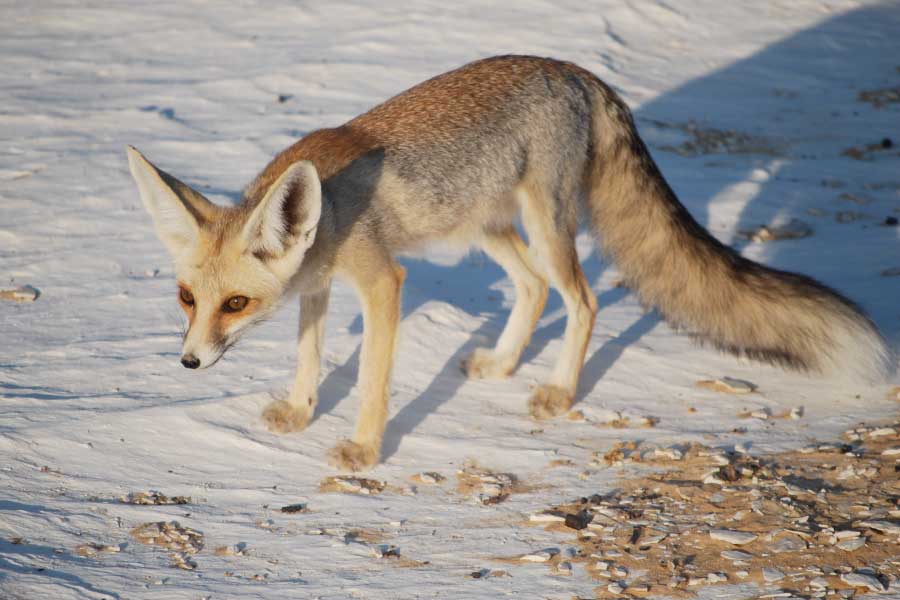
- Scientific name: Vulpes rueppelli
- Where constitute: North Africa, Middle East
- Conservation status: Least Business organization
Rüppell's flim-flam is a small desert fox found in North Africa and the Heart E. Named after the German language naturalist Eduard Rüppell, the species has a pale sandy-coloured coast and large ears. It is somewhat similar in advent to the smaller Fennec Fox, another African desert species.
Back to index
Sechuran Fox
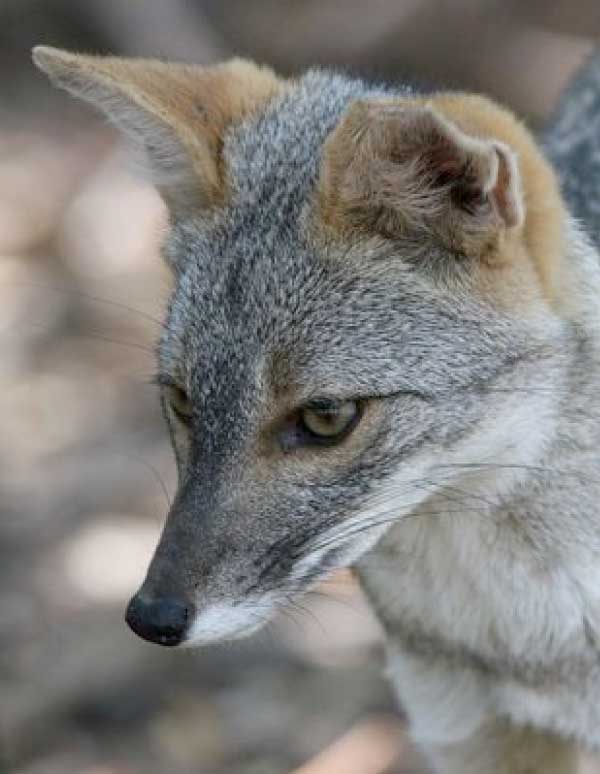
- Scientific name: Lycalopex sechurae
- Where establish: South America (Republic of peru & Ecuador)
- Conservation status: Near Threatened
The Sechuran Trick is the smallest fellow member of the zorro, or 'false fox' genus, Lycalopex. This pale, xanthous-gray fox is institute in forests, grasslands and deserts in Ecuador and Republic of peru. Information technology is threatened by habitat loss, and is listed as Near Threatened past the IUCN.
This nocturnal species feeds mainly on insects and plants, and may be able to survive on a mainly herbivorous diet.
Back to index
Brusque-Eared Domestic dog
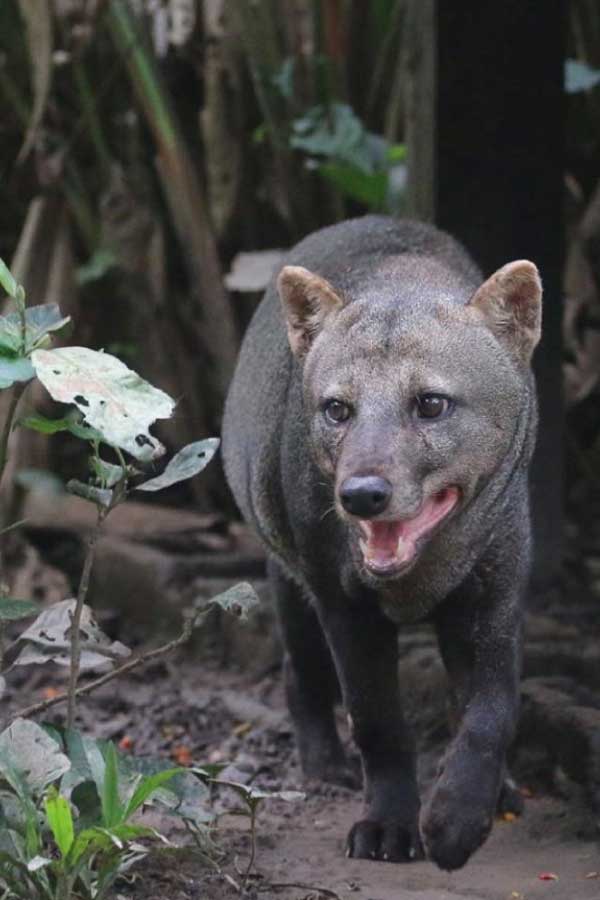
- Scientific proper noun: Atelocynus microtis
- Where found: S America
- Conservation status: Near Threatened
The Short-Eared Dog lives in the Amazon Rainforest in Colombia, Ecuador, Peru, Bolivia and Brazil. Despite having a wide range this secretive canid is seldom seen. Like many animals found in the Amazon Rainforest, the short-eared dog is at hazard from habitat loss. Its conservation status is Near Threatened.
The Curt-Eared Domestic dog has a short, nighttime coat and modest, rounded ears. Information technology has slightly-webbed paws, and may accept a partially aquatic lifestyle.
Back to index
Side-Striped Jackal
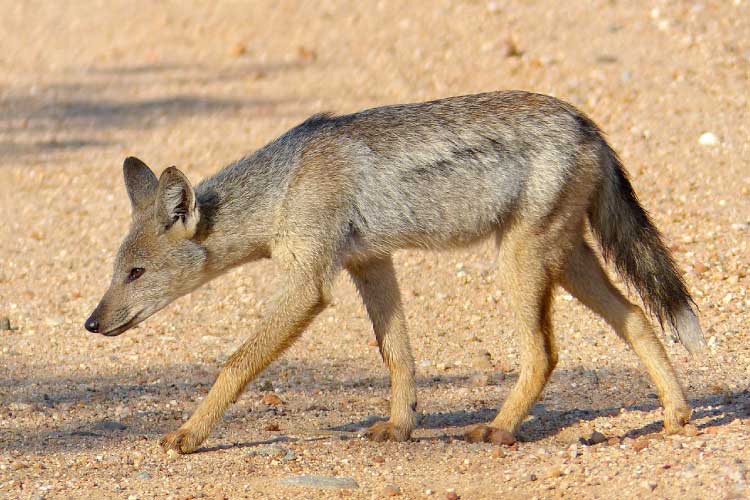
- Scientific proper name: Canis adustus
- Where institute: Africa
- Conservation status: Least Concern
Named after the stripe that runs along either side of its trunk, the side-striped jackal is a mid-sized canid establish beyond much of sub-Saharan Africa (the region southward of the Sahara Desert). Like the black-backed and gold jackals, it belongs to genus Canis. It is more closely related to the blackness-backed jackal than information technology is to the gold jackal of Europe.
The side-striped jackal is less cannibal than the other two jackals. Fruit tin can make up up to 30% of its diet at certain times of the yr.
Back to index
South American Gray Trick
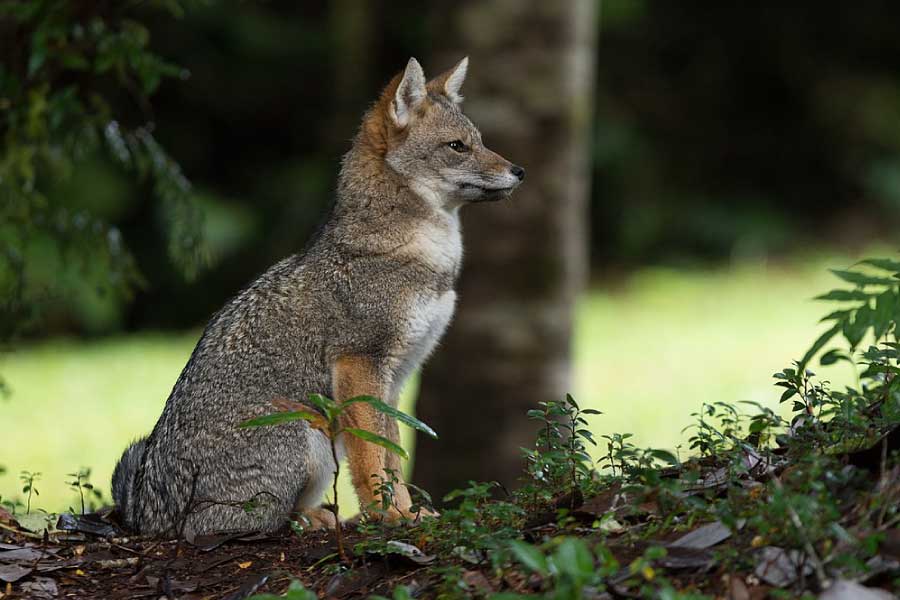
- Other name(s): Patagonian fox, chilla, gray zorro
- Scientific name: Lycalopex griseus
- Where found: South America
- Conservation status: To the lowest degree Concern
The South American gray fox is the about mutual member of the genus Lycalopex (the 'zorro' or 'fake fox' genus). The species is institute in Chile and Argentina, where it typically inhabits grasslands.
This small fox is still hunted for its stake, rufous-tinged glaze. Despite this, the species has the conservation condition of Least Concern and its population is stable.
Today, several authorities consider the Southward American grey play tricks and the Pampas fox to be the same species.
Back to index
Swift Fob
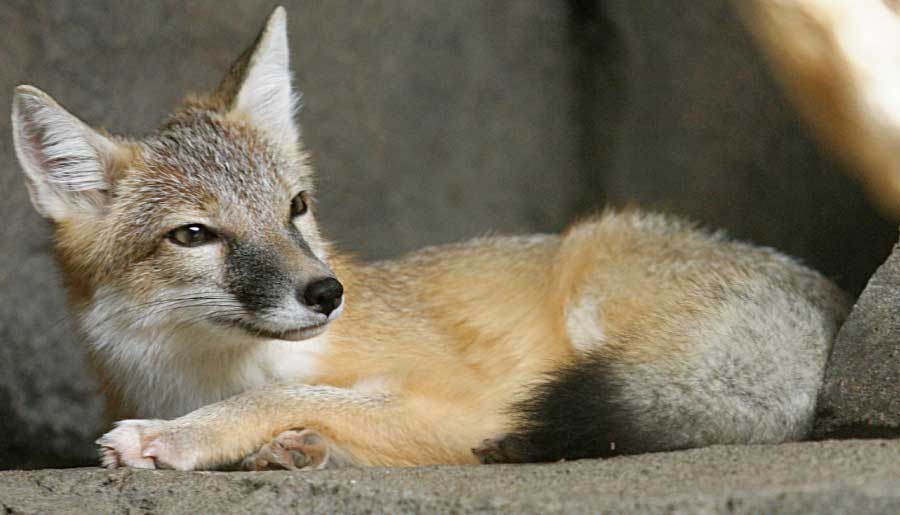
- Scientific name: Vulpes velox
- Where found: Us
- Conservation status: To the lowest degree Business organization
The swift play tricks lives in the prairie grasslands of the Great Plains region of the U.s. and parts of southern Canada.
Virtually the size of a Domestic Cat, the swift play a joke on is pale xanthous and white in color. Its ears are large and pointed. It is closely related to the kit fox, another North American canid.
During the early 20th century, as a result of heavy persecution, the swift fob was extirpated in much of its former range. Successful conservation and re-introduction programs have seen the species' population bounce back.
Although the species is no longer considered to be threatened, today it is merely present in 44% of its original range in the United states, and iii% of its original range in Canada.
- You can discover out more than about the swift play a joke on on this folio: Swift Flim-flam Facts
Back to index
Tibetan Sand Fox
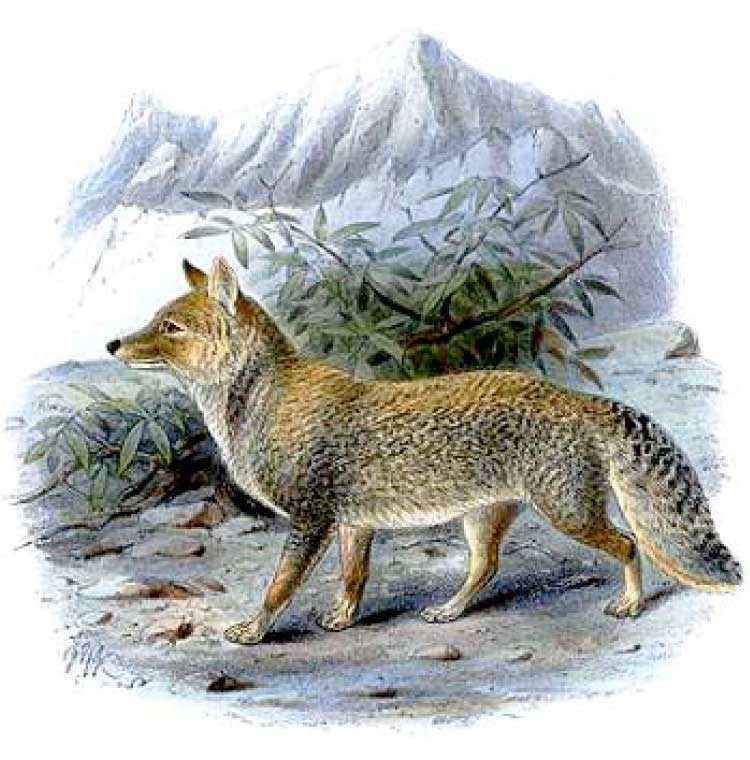
- Scientific name: Vulpes ferrilata
- Where plant: Asia
- Conservation status: Least Concern
The Tibetan sand fox lives on treeless grasslands on the Tibetan Plateau and surrounding areas. It is a fellow member of the Vulpes, or 'true play a trick on', genus, and has a typically fox-like advent, with reddish-grey fur and a bushy tail. The species' preferred casualty is the plateau pika, a small mammal that, similar the pull a fast one on, lives in montane and alpine regions.
Dorsum to index
Other Wild Dog Species / Subspecies
Cozumel Pull a fast one on
(No image available)
- Scientific name: Undescribed Species
- Where found: Mexico
- Conservation status: Unassessed
The Cozumel trick is a minor canid related to the gray flim-flam and island fox. The species is institute simply on Cozumel, a Mexican isle. Picayune is known about the species, which, having not been seen since 2001, may now be extinct.
Back to index
Dingo
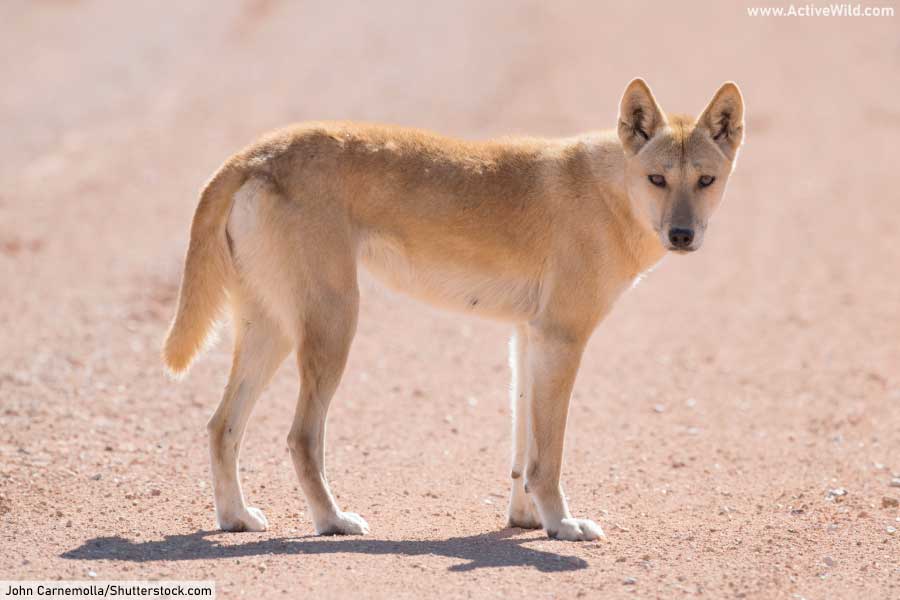
- Scientific name: Dog / Canis familiaris dingo / Canis lupus dingo
- Where found: Australia
- Conservation status: Domestic / Unassessed
The Dingo is an Australian wild dog institute in grasslands and deserts beyond much of Australia. This distinctive, sandy-gold-colored canid is the largest predator in Commonwealth of australia. Information technology hunts a broad range of small animals, including rabbits, kangaroos, rats and birds.
There is some debate over whether the dingo should be classified either as: a domestic canis familiaris, a domestic dog subspecies, or a grey wolf subspecies. Its ancestors were domestic dogs brought to the continent around 4,000 years ago. Inbreeding with feral domestic dogs has acquired the number of 'pure' dingoes to decline.
- Yous tin find out more about dingoes on this folio: Dingo Facts.
Back to index
Domestic Canis familiaris

- Scientific name: Dog / Canis lupus familiaris
- Where establish: All continents except Antarctica
- Conservation status: Domestic
The canis familiaris is either regarded as being a subspecies of grey wolf (Canis lupus familiaris), or as a divide species (Dog). Its ancestors were gray wolves that were domesticated at least 10,000 years ago, and perhaps as long every bit forty,000 years agone.
There are betwixt 700 million and 987 million domestic dogs alive today. Many are either kept every bit pets or are feral, merely some are even so bred to work. Roles that dogs perform include: beast herding, security, hunting, and assisting the disabled.
In countries such as Korea, Prc and Vietnam, dog meat forms part of the traditional diet.
Domestic dogs can interbreed with grey wolves, but pure grey wolves are more often than not bigger, with bigger paws, larger brains in relation to their size, erect ears and tails that indicate downwards.
- Yous tin find out more than about the domestic canis familiaris on this page: Dog Facts
Back to index
Ruby Wolf
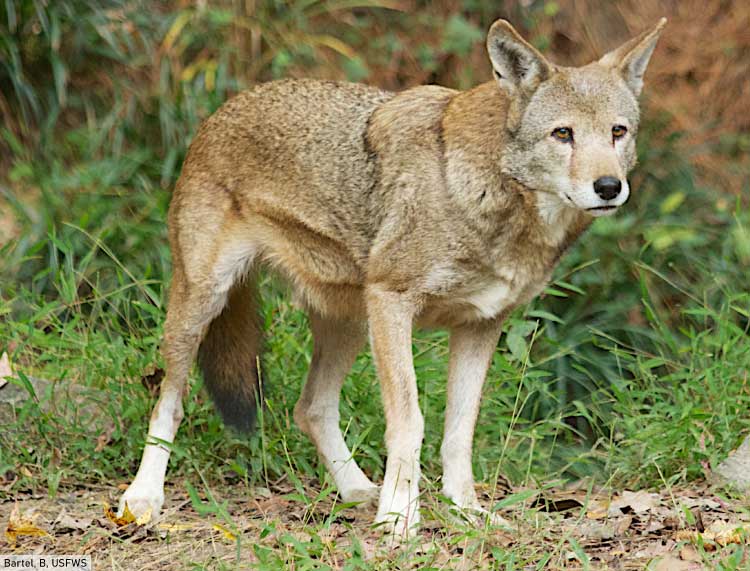
- Scientific proper name: Canis lupus rufus /Canis rufus
- Where found: U.s.
- Conservation status: Critically Endangered
The carmine wolf is a large canid found in the southeastern United States. It is somewhere between a coyote and a grey wolf in both size and appearance. The red-grayness color of its coat gives the species its proper name.
With a conservation status of Critically Endangered, the ruby-red wolf is one of the near threatened wild dogs.
In the 1980'southward the crimson wolf was declared extinct in the wild. Due to a captive breeding programme that began in the 1970'southward, the species was able to exist re-introduced in Northward Carolina. Despite this, only betwixt twenty and 30 adult cherry-red wolves exist in the wild.
In that location is some debate over the crimson wolf'south taxonomic status, with many authorities not recognizing information technology as a separate species. Some consider the cerise wolf to be a coyote / gray wolf hybrid; others believe it to be a grey wolf subspecies.
- You lot can observe out more about the cherry wolf on this page: Carmine Wolf Facts
Back to index
Wild Domestic dog Species List: Conclusion
We hope that yous have enjoyed finding out about all of the unlike types of wild dogs. You can find out more about the animal kingdom on the pages below:
- Explore the cat family: Wild Cats Listing with Pictures and Facts: Discover EVERY member of the cat family
- Find out more than about Carnivora and the different types of mammals: Types of Mammal
- Discover astonishing animals from all effectually the world: A to Z Animals Listing with Pictures and Facts
Source: https://www.activewild.com/wild-dog-species-list/
Posted by: shiressucarty.blogspot.com

0 Response to "Which Of These Animals Is The Largest Member Of The Dog Family?"
Post a Comment